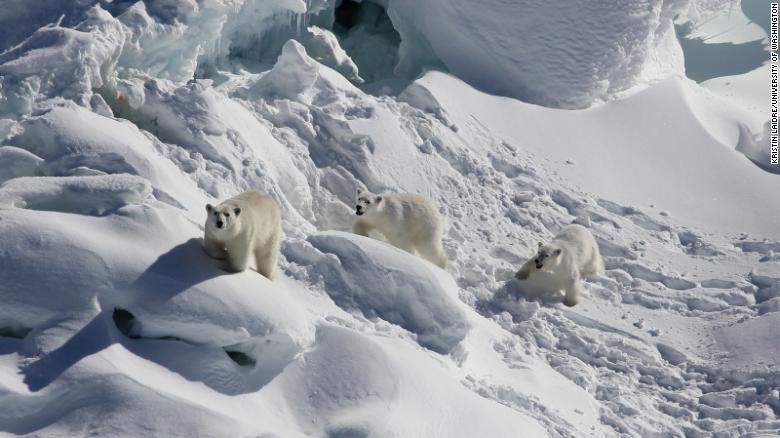
(CNN) – A genetically distinct and isolated population of polar bears have been documented living in southeast Greenland.
Scientists who studied and tracked the bears determined that they survive despite having limited access to sea ice — something that is critical for polar bears — and instead use the freshwater ice supplied by Greenland’s ice sheet.
A study describing the bears was published Thursday in the journal Science.
“We wanted to survey this region because we didn’t know much about the polar bears in Southeast Greenland, but we never expected to find a new subpopulation living there,” said lead study author Kristin Laidre, a polar research scientist at the University of Washington’s Applied Physics Laboratory, in a statement.
“We knew there were some bears in the area from historical records and Indigenous knowledge. We just didn’t know how special they were.”
An icy necessity
Traveling far, the 19 known polar bear populations rely on sea ice to hunt their prey, like ringed seals, and sit near breathing holes to capture their prey. The calories provided by seals can help them store energy for months when food and sea ice is more scarce.
Global warming is causing sea ice to rapidly melt and disappear as the Arctic warms more than twice as fast as the rest of the planet. When sea ice disappears, polar bears must move on land, which affords them fewer opportunities for food.
Meanwhile, the southeast Greenland polar bears tend to stick close to home, so they have adapted to their environment in a unique way. Although they are isolated due to the Greenland ice sheet, mountains, open water and fast-flowing coastal currents, the polar bears have access to freshwater ice and some limited access to sea ice, which helps them catch seals.
The bears can use sea ice between February and late May. For the rest of the year, they hunt seals using the freshwater ice as it breaks away from the ice sheet.
“Polar bears are threatened by sea ice loss due to climate change. This new population gives us some insight into how the species might persist into the future,” said Laidre, also a University of Washington associate professor of aquatic and fishery sciences.
“But we need to be careful about extrapolating our findings, because the glacier ice that makes it possible for Southeast Greenland bears to survive is not available in most of the Arctic.”
The environment of southeast Greenland is a unique, small-scale climate refuge where the bears can survive, and similar habitats can be found along Greenland’s coast and the Norwegian island of Svalbard.
“These types of glaciers do exist in other places in the Arctic, but the combination of the fjord shapes, the high production of glacier ice and the very big reservoir of ice that is available from the Greenland Ice Sheet is what currently provides a steady supply of glacier ice,” said study coauthor Twila Moon, deputy lead scientist at the US National Snow and Ice Data Center in Boulder, Colorado, in a statement.
“In a sense, these bears provide a glimpse into how Greenland’s bears may fare under future climate scenarios,” Laidre said. “The sea ice conditions in Southeast Greenland today resemble what’s predicted for Northeast Greenland by late this century.”
Aerial research
The new study is comprised of 30 years of historical data from Greenland’s east coast and seven years of new data from the southeastern coast. The latter is a remote region with sharp mountains, heavy snow and unpredictable weather, making it difficult to study.
The research team spent two years consulting with polar bear subsistence hunters, who hunt for survival, rather than sport, in eastern Greenland. The hunters were able to share their expertise and contribute samples for genetic analysis.
The researchers, working with the Greenland Institute of Natural Resources in Nuuk, Greenland, were able to study and track the bears using helicopters as the researchers flew over sea ice, estimating that there are a few hundred bears living in the remote area. This is similar to other small populations of polar bears elsewhere.
The female southeastern Greenland polar bears are more diminutive than female polar bears in other regions. The smaller bears have fewer cubs as well, which could be connected to trying to find mates as they travel the surrounding fjords and mountains. But the researchers won’t know for sure until they have more data from long-term monitoring of the bears.
The bears either travel over ice within fjords or climb over mountains to reach neighboring fjords. Of the 27 bears tracked during the study, half of them accidentally floated for about 120 miles (190 kilometers) south on average, stuck on small ice floes caught within the strong East Greenland coastal current.
Once the bears had a chance, they just hopped off of the ice and trekked back to the fjord they call home. Created by glaciers, fjords are long, narrow, deep sea inlets found between high cliffs.
“Even with rapid changes happening on the ice sheet, this area in Greenland has the potential to continue to produce glacial ice, with a coast that may look similar to today, for a long time,” Moon said.
The researchers warn, however, that this habitat may not be enough for other polar bears suffering in the wake of the climate crisis.
“If you’re concerned about preserving the species, then yes, our findings are hopeful — I think they show us how some polar bears might persist under climate change,” Laidre said.
“But I don’t think glacier habitat is going to support huge numbers of polar bears. There’s just not enough of it. We still expect to see large declines in polar bears across the Arctic under climate change.”
Uncertain future
The researchers believe the southeast Greenland polar bears have evolved in isolation for several hundred years. The earliest known reference to bears in this location dates to the 1300s, and the first written record of the animals among the region’s fjords is from the 1830s, according to the study authors.
The status of the polar bears remains unknown. Researchers don’t know if the population is stable, increasing or decreasing, but more monitoring could reveal what the future holds for this unique population, Laidre said.
Due to their isolation, the polar bears are so genetically distinct that the researchers propose that the southeastern Greenland polar bears should be considered the 20th subpopulation of the species.
Ultimately, that determination is up to the International Union for the Conservation of Nature, which helps to oversee protected species. And Greenland’s government will make any decisions regarding protection for the bears.
“Preserving the genetic diversity of polar bears is crucial going forward under climate change,” Laidre said. “Officially recognizing these bears as a separate population will be important for conservation and management.”
Meanwhile, sea ice continues to decline in the Arctic, which greatly reduces survival rates for most polar bear populations going forward.
“Climate action is the single most important thing for the future of polar bears,” Laidre said.




